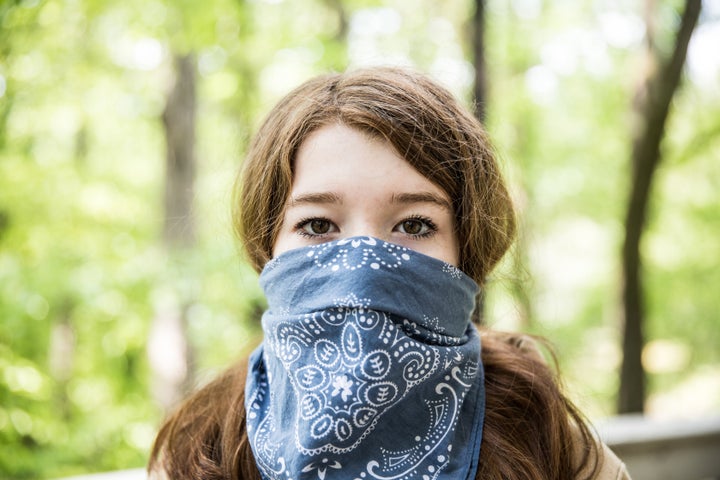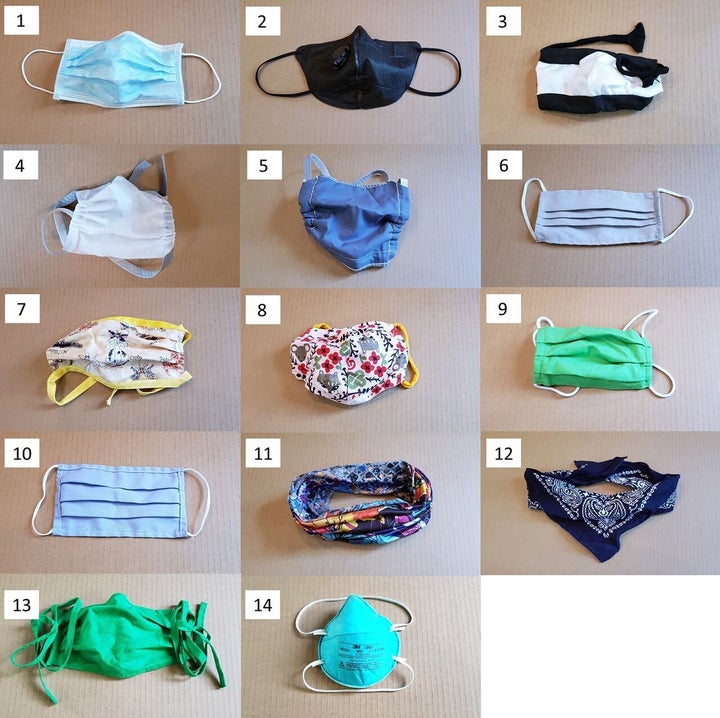We’re here to guide you through the coronavirus pandemic. Sign up to the Life newsletter for daily tips, advice, how-tos and escapism.
Wearing a neck fleece (or snood) as a face covering could actually increase your risk of spreading coronavirus, new research suggests. Meanwhile wearing a scarf or bandana offers “very little” help to stop the spread of Covid-19.
Researchers from Duke University in North Carolina tested 14 different face coverings to see which type was most effective at limiting the spread of droplets. The coverings ranged from homemade material masks to the professional, hospital-grade masks worn by frontline healthcare workers.

The best face coverings were N95 masks without valves (number 14 in the image below), which are hospital-grade coverings used by frontline workers. Surgical or polypropylene masks also “performed well”.
Handmade cotton face coverings provided “good coverage”, the researchers said, “eliminating a substantial amount of the spray from normal speech”.
On the other hand, bandanas and neck fleeces, such as balaclavas or snoods, didn’t do much at all to block the droplets.

To test the effectiveness of the designs, an operator wore each mask, then spoke in the direction of a laser beam inside a dark enclosure.
Droplets shown through the laser were recorded using a camera and counted using a computer programme. These were then compared to a control test, where the operator was not wearing a mask.
The results, published in the Journal Science Advances, suggest while some masks do little to stop droplets spreading, fleece neck coverings (when pulled up to the face) actually increase the amount of droplets spread to 110% (compared to the 100% control).
The researchers attribute this increase to “the neck fleece dispersing larger droplets into several smaller droplets, therefore increasing the droplet count”.
Smaller participles “tend to hand around for longer in the air and can get carried away easier,” PhD researcher Martin Fischer explained in a video on Duke ’s website.
On a positive note, the study did show wearing a cotton mask or surgical mask when out and about is worth the effort.
“We confirmed that when people speak, small droplets get expelled, so disease can be spread by talking, without coughing or sneezing,” Fischer said. “We could also see that some face coverings performed much better than others in blocking expelled particles.”
Here’s a list of all 14 masks tested, ranked from most effective to least – as well as their corresponding number on the image above.
1. N95 mask, no exhalation valve, fitted (image 14)
2. Surgical mask (1)
3. Cotton-polypropylene-cotton mask (5)
4. Two-layer polypropylene apron mask (4)
5. Two-layer cotton, pleated style mask (13)
6. Two-layer cotton, pleated style mask (7)
7. N95 mask with exhalation valve (2)
8. Two-layer cotton, Olston style mask (8)
9. One-layer Maxima AT mask (6)
10. One-layer cotton, pleated style mask (10)
11. Two-layer cotton, pleated style mask (9)
12. Knitted mask (3)
13. Bandana (12)
14. Gaiter type neck fleece (11).
